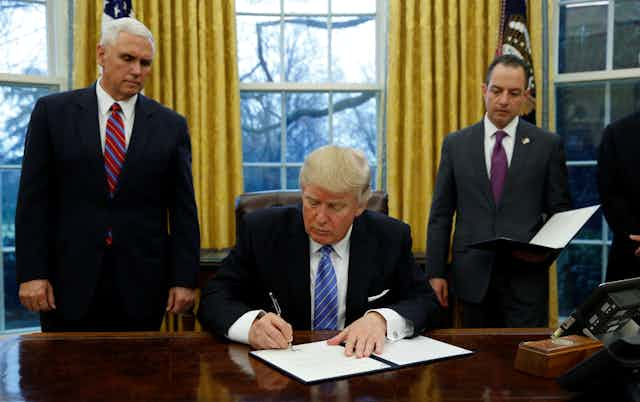True to his promise, President Donald Trump withdrew the US from the Trans Pacific Partnership within 72 hours of assuming office. His decision has many implications for trade and geostrategic issues in the Asia Pacific, and remaining members are planning to meet and discuss their options.
The TPP is an ambitious regional trade agreement comprising 12 countries – Australia, Brunei, Canada, Chile, Japan, Malaysia, Mexico, New Zealand, Singapore, Peru, Vietnam and the United States – accounts for around 40% of world GDP.
Negotiations concluded in October 2015, and the deal was signed by members in February 2016. But it needed to be ratified by at least six signatories – accounting for 85% of the total GDP of the bloc – to come into force.
Unless the US, which is the largest economy in the bloc, ratifies, it cannot. And, in this sense, the agreement is no longer a possibility.
Reports of an early death
The Trans Pacific Partnership ran into rough weather during the US presidential election campaign last year; opposition to the deal was bipartisan. Apart from Trump, Bernie Sanders was heavily opposed to the agreement. Even Hillary Clinton, who supported it during her tenure as Secretary of State in the Obama administration, began opposing it soon after the text of the agreement became public.
Indeed, there was hardly any prominent political voice in favour of the Trans Pacific Partnership during the election campaign.
Although the Obama administration remained committed until the very end, the chances of it being taken forward for ratification by a new administration – headed by either Hillary Clinton or Donald Trump – were distinctly remote. Clinton would have at the very least called for renegotiation.
Other members were hoping that the conclusion of the election would lead to a more objective assessment of the agreement by the new administration. But Trump’s swift action has dashed all such hopes.
Is it the end of the road for the agreement then? Other members, such as Australia, Japan, Canada and New Zealand have repeatedly affirmed their commitment to the agreement over the past few months. But are they be willing to move ahead without the US?
Failed pivot
The TPP would not be the same without the US. The economic size of the agreement would reduce significantly, along with its geostrategic importance.

The Trans Pacific Partnership was a key element of the Obama Administration’s “pivot to Asia”: a strategy for establishing a US-led regional order in the Asia Pacific. All non-US members are strategic allies and partners of the US.
They were enthusiastic about the agreement as it aimed to institutionalise common rules for trade and business fashioned by the US. The country’s withdrawal greatly reduces the possibility of a US-led regional order in the Asia Pacific.
It also creates a vacuum in regional economic leadership.
Australia has already begun searching for solutions to revive the agreement. the government there says it’s willing to push ahead with the Trans Pacific Partnership without the US and to reformulate the deal to include presently excluded countries, such as Indonesia and China.
But China’s entry might be opposed by existing members such as Japan and Vietnam due to their awkward geopolitical relations with the country.
End of the line
If the remaining members of the Trans Pacific Partnership decide to reformulate the agreement to make it work without the US, then the Asia-Pacific region could still have a trade agreement that’s more modern and ambitious than most other trade agreements in the world. Successful implementation would send a strong signal about the region’s commitment to free trade and globalisation.
But the agreement could be as good as dead if, instead of pushing ahead without the US, its members decide to explore bilateral trade agreements with the country. This is exactly what the Trump administration will be hoping for.
Donald Trump’s trade policy is to deal bilaterally with countries rather than in a regional framework. One-on-one negotiations give more chances to the US to maximise the interests of American industries and workers.
The US may hope to work out bilateral trade deals with those Trans Pacific Partnership members with whom it doesn’t have similar accords already, such as Japan, Malaysia, Brunei, Vietnam and New Zealand.
Regional trade frameworks bind all members to a common set of rules. But the US can use its strategic influence and its role as a security provider to persuade allies, such as Japan, to enter into bilateral agreements instead.
If it succeeds in doing so, many Trans Pacific Partnership signatories may lose interest in a regional trade agreement. And that would certainly be curtains for accord.

